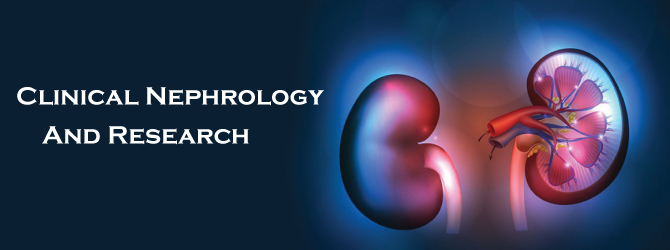
Sign up for email alert when new content gets added: Sign up
Hassan Ali Elsayed Abdelwahed
Jazan Armed Forces Hospital, Saudi Arabia
ScientificTracks Abstracts: Clin Nephrol Res
Statement of the Problem: Diabetic Kidney Disease (DKD) is highly prevalent among patients with diabetes mellitus. It affects approximately 20% of diabetic patients. The objectives of the present work were to assess patterns of albuminuria and determine microalbuminuria predictors among patients living with Type 2 Diabetes (T2D) who attended the family medicine department of Jazan Armed Forces Hospital. Methodology & Theoretical Orientation: The study participants were screened for albuminuria and classified into three categories or grades, A1, A2 and A3, based on the urine Albumin/Creatinine Ratio (ACR). Category A1 included T2D with normal to mildly increased albuminuria (ACR <30 mg/gm; n, 532). The second category, A2, included those with microalbuminuria with ACR of 30-300 mg/gm; n, 202. The 3rd one, A3, was severely increased albuminuria with an ACR of >300 mg/gm; n, 30. A case-control design was used and included two groups (n, 202/group), one with microalbuminuria and the other with a normal urine (ACR). Data regarding patient history, glycosylated hemoglobin (HbA1c), lipid profile, renal function tests, ACR, ASCVD (atherosclerotic cardiovascular disease) risk, etc., were collected. Findings: The prevalence rates of microalbuminuria and macroalbuminuria were 26.4% and 3.9%, respectively. HbA1c was significantly higher in patients with microalbuminuria (9.3 ±2.2; P˂0.001) and macroalbuminuria (10.5±2.3; P˂0.001) than in those with normal ACR (8.3 ±1.9%). The predictors of microalbuminuria were poor glycemic control with HbA1c ≥ 7% {OR, 2.5 (95% C. I, 1.5-4.2)}; hypertension {(OR, 1.8 (95% C. I, 1.2-2.8)}; estimated Glomerular Filtration Rate (eGFR) of ˂90 mL/min/1.73 m2 {OR, 2.2 (95% C. I, 1.4- 3.6}; smoking {OR, 1.3 (95% C. I, 0.7-2.6}; and body mass index {OR, 1.05 (95% C. I, 1.01-1.09}. Conclusion & Significance: Microalbuminuria is highly prevalent among patients with type 2 diabetes and is associated with poor glycemic control and hypertension, necessitating aggressive and timely screening and treatment. Recent publications 1. Abdelwahid HA, Dahlan HM, Mojemamy GM, Darraj GH. Predictors of microalbuminuria and its relationship with glycemic control among Type 2 diabetic patients of Jazan Armed Forces Hospital, southwestern Saudi Arabia. BMC Endocr Disord. 2022 Dec 8;22(1):307. doi: 10.1186/s12902-022-01232-y. PMID: 36482350; PMCID: PMC9733223.. 2. Sameer Ahmed Ali Holal, Hassan Ali Elsayed Abdelwahid. Barriers Facing Primary Health Care Physicians in Jazan when Dealing with Emergency Cases. World Family Medicine. 2022; 20(4): 32-43. DOI: 10.5742/MEWFM.2022. 3. Abdelwahid HA, Al-Shahrani SI, Elsaba MS, Elmorshedi WS. Patterns of referral in the Family Medicine Department in Southeastern Saudi Arabia. Saudi Med J. 2010 Aug;31(8):925-30. PMID: 20714694.5.
Hassan Ali Elsayed Abdelwahed, Professor of Family Medicine, Suez Canal University. has completed his MD (Medical doctorate) in 2002. Egypt. He also is a Consultant of family medicine in Jazan Armed Forces Hospital (JAFH), Saudi Arabia. He is interested in the management of chronic diseases, ECG, anemia, Epidemiology, Health education, research and adult learning. He is the Head of the Institutional Research Board of JAFH. He is serving as a member of the faculty research committee and as an editorial member or reviewer of several reputed journals like Elite Research Journal, International Blood Research & Reviews , American Journal of Clinical Medicine Research (http://www.sciepub.com/journal/AJCMR), American Journal of Public Health Research, British J. of Medicine and medical research (BJMMR), etc. Based on his research and CV, He has been included in the book Who's Who in the World.